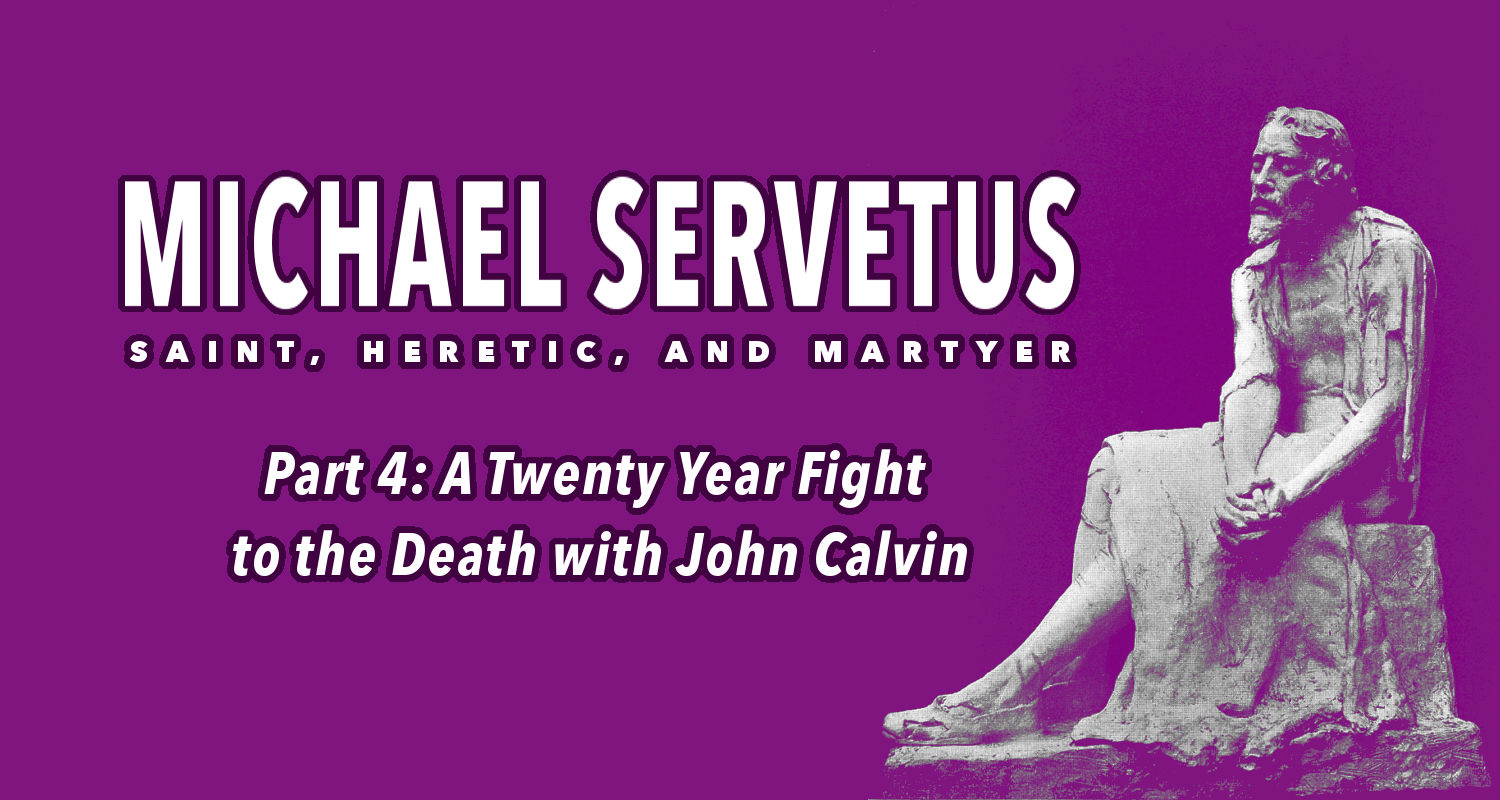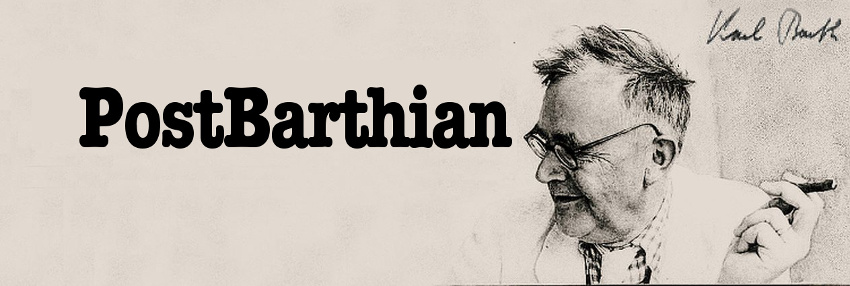
Calvin vs Servetus: a twenty year fight to the death
Michael Servetus (1511-1553) came in conflict with John Calvin (1509-1564) in the early 1530's and their correspondences spanned twenty years. "A strange mixture of fascination and repulsion haunted the relations between these two men. Many long years passed before the battle to the death began which ended in Servetus' burning." [1] At early times they exchanged letters using pseudonyms and at later times, they quarreled face-to-face. Servetus had many opponents, but John Calvin was a living effigy of everything Servetus fought against.
Round One: The fight begins
John Calvin and Michael Servetus became acquainted in the early 1530's in Paris, and they initially corresponded through pseudonyms. Servetus had fled to Paris after publishing his On the Errors of the Trinity (1531), and assumed the alias of "Michel de Villeneuve" [2] to mask his identify from the Holy Inquisition and his other critics of his radical theology of restoration. Calvin responded in kind with his own pseudonym of "Charles d'Espeville" [3] (or "Charles Despeville") but Calvin had different reasons for hiding, such as his recent break from Catholicism, embrace of the Reformation, and involvement in controversies in Paris at that time.
Theodore Beza reports that as early as 1534, "Calvin agreed to meet him [Servetus] in the hope of silencing him, or of convincing and reproving him from the Word of God. Calvin kept the appointment . . . but Servetus did not turn up." [4] Unfortunately, Servetus had been prevented from meeting Calvin in person at the last minute.
In 1536, John Calvin published the first edition of his magnum opus, The Institutes of the Christian Religion (1536)—a book that remains to be an icon of the Reformation—and Calvin's theological system became the best expression of Reformation orthodoxy. Consequently, Servetus viewed the person and works of Calvin as an embodiment of everything he opposed and Servetus became obsessed with defeating his archnemesis. Calvin's motivation is more complicated, he published his first edition of the Institutes, and did not wish it to be challenged by any rival, even an amateur theologian like Servetus. Cottret said that "The struggle between Calvin and Servetus was an authentic defiance of the strong by the weak" [5] respectively.
John Calvin is indebted to Michael Servetus for inspiring Calvin's first theological publication, Psychopannychia (1532), which was a refutation of the "Anabaptist" notion of "soul sleep" in the intermediate state between death and the resurrection. "Calvin's earliest theological work, the Psychopannychia, was at least in part directed against views attributed to Servetus and his circle in Paris." [6] Also, Calvin's first edition of his Institutes of the Christian Religion (1536), may have been inspired based upon his correspondences with Servetus. Calvin and Servetus had a symbiotic relationship, and dialectically speaking, or in the sense of iron sharpening iron. John Calvin may never have realize his [in]famous Institutes of the Christian Religion (1559) or radically influenced the future of the Reformed Church, Protestant Church, and the universal church today, unless he had quarreled with Servetus from the very beginning of his theological career.
Round Two: Calvin and Servetus face-to-face
Correspondence between Calvin and Servetus continued for twelve years after their first failed attempt to meet in 1534, and at last they did meet in 1546 in a famous encounter that Bernard Cottret described as follows:
"Immediately a rather silly authors' quarrel began, accompanied by a theological debate. With an assurance close to impudence, Servetus immediately began giving Calvin lessons in christology and the baptism of the newly born. Calvin answered, but Servetus referred him to the manuscript of his Restitutio [The Restoration of Christianity]. Calvin, in turn, urged Servetus to read carefully and meditate on his own Institutio [The Institutes of the Christian Religion]. Servetus compiled and returned his copy of this work to Calvin, covered in the margin with his own critical annotations. Calvin could not permit the Institutes, the work of his life, to be debated. He preferred charitably, not to respond to this amateur theologian. Servetus persisted, but Calvin refused to continue corresponding with this bore, who sent him no less than thirty letters. Impassive, Calvin remained mute, and did not even design to return the Latin manuscript of the Restitutio to the Spaniard." [7]
After their face-to-face encounter, Cottret says "on Feb 13, 1547, Calvin allowed his anger to show in two letters, one to Jean Frellon, the other to Farel." [8] To William Farel (a.k.a. Guillaume Farel), John Calvin prophetically writes: "Servetus recently sent me with his letters a new volume of his ravings. . . . He would come here if I agreed. But I will not give him my word; for if he came, as far as my authority goes, I would not let him leave alive." [9] Calvin's statement is an idle threat made in confidence to a close friend, and is not a plot to kill Servetus, similar to the common expression "I'm so angry, I could kill him!" Calvin wanted Servetus to recant, as Beza said.
Bernard Cottret reports the "Calvin bearded Servetus by refusing to return the manuscript of his book; Servetus persisted in provoking Calvin. He considered himself a David confronting the Genevan Goliath." [10] Calvin was aware that Servetus had not yet published his Restitutio, and likely retained the manuscript to silence this rival to his Institutio.
Round Three: Calvin strikes back
In 1550, John Calvin published On Scandals, which contained public repulsions of Michael Servetus. In Calvin: A Biography, Bernard Cottret provides a full page quote from On Scandals (1550) on Servetus. Here are a few sample quotes: Calvin writes "There is a certain Spaniard named Michael Servetus who pretends to be a doctor, calling himself Villeneuve. This poor braggart, already inflated with the arrogance of Portugal, but bursting even more with his own pride, thought he could acquire great fame . . . by overthrowing all the principles of Christianity [i.e. Calvin's Institutes]". [11] And, "In this book he [Servetus] wrote he shows himself such a mad dog, barking and biting, without sense or reason, that it can be clearly seen what spirit drives him . . . he is a man hungry for glory, who drinks in the dreams he can find to get drunk on." [12] And, Servetus "assembles I do not know what speculations so clumsy and unsupported that there is no one of sound understanding who would not judge that there has never been a man who drivelled like this unless he was bewitched by foolish self-love." [13]
Cottret also reports that Michael Servetus responded to John Calvin in similar harsh words: "Your Gospel is without God, without real faith, without good works. In place of God you have a Cerberus with three heads. For faith you have a fatalistic dream, and according to you good works are vain images." [14] (It may be worth remembering that in 16th century rhetoric, it was very common for opponents to call their opponents vulgar terms as such.)
Before 1550, John Calvin had opposed the punishment of heretics by the magistrate, and argued in his Institutes of the Christian Religion that the most severe punishment for heretics was excommunication. Starting with On Scandals (1550) began to argue that the magistrate may use the sword against heretics who injure the church or the state. Bernard Cottret believed that Calvin had succumbed to political pressures in Geneva, and as a magisterial reformer, he turned to the magistrate in Geneva to overcome popish plots to persecute him. Cottret speculates that "'The Restoration of Christianity' gained influence and spread to Geneva to the chagrin of those loyal to John Calvin. The Calvinists believed that Servetus' heretical book was only always to be published because their Catholic enemies supported it" [15]
Round Four: Servetus raids Geneva
In 1553, Servetus finally published his Christianismi Restitutio (The Restoration of Christianity). Cottret suggests that even the title of Servetus' "Restitutio" [Restoration of Christianity] was a "criticism and antithesis" of Calvin's "Institutio" [Institutes of the Christian Religion]. The publication of Servetus' Restitutio at the beginning of 1553, resulted in his execution at the end of 1553. Bruce Gordon said "When Servetus published 'On the Restoration' in 1553, . . . John Calvin informed the authorities in Vienne, . . . that they had a notorious heretic in their midst. Servetus was arrested and tried, but managed to escape." [16] (Gordon reports that John Calvin worked with the Catholic Church and the French authorities to apprehend Servetus, and this appears to invalidate Cottret's speculation that Calvin feared that that the Catholic Church was supporting Servetus.) Bernard Cottret also reports that Servetus managed to escaped execution by the French authorities: "Servetus contrived to escape over the rooftops on April 7. He was condemned in absentia on June 17. The sentence was executed by burning him in effigy along with five bales of blank paper, used to represent his works." [17]
Servetus escaped his execution in the spring by the Catholics in France, only to be recaptured and executed in the fall by the Protestants in Geneva. After Servetus escaped, he was on the run with no where to go. He could not return to France now. He could not go back to Spain because "as for the Holy Inquisition, it feverishly watched for the return of the prodigal son. Where could he go? All doors, closed, one after another." [18] Servetus said "such was the blindness of the world that I was sought for up and down to be led to my death. . . . With Jonah I longed rather to flee to the sea or to one of the new isles." [19] But, Servetus could not even flee across the Atlantic to the New World either, because "What America, however, would permit Servetus, the servant of Jesus, to find repose?" [20] The whole world desired the death of Michael Servetus, a man whom they considered to be a sub-human, monstrous heretic, and Servetus was prepared to defend his theology, even unto death.
Servetus had no were else he could go to escape—Servetus' works were already publicly refuted by Martin Bucer and banned in Basil and Strasbourg—so he could not seek refuge in the Swiss Protestant cities. So at last resort, Servetus decided to face his destiny and go to Geneva where he may confront John Calvin face-to-face, a man that he had challenged for decades, and who stood in effigy for the whole world that opposed him. "Servetus' repeated attempts to make contact with Calvin bordered on obsession. His arrival in Geneva was a provocation shaped by an apocalyptic view that in the final days as the Four Horsemen rode across Europe he would confront the man he held responsible for turning the Reformation into a new Rome. Servetus had arrived to make his final stand. In Geneva he would give a full account of his views, and die a martyr. There would be no more flight or hiding—it was a time to face his persecutors, and his most hated enemy." [21].
Final Round: Servetus is burned alive at the stake
I already described how the twenty year fight to death ends with Michael Servetus burned alive at the stake in the gates of Geneva in Part One of this series. In Part Five, I will write a defense of John Calvin.
- Michael Servetus: Saint, Heretic, and Martyr (Part 1: Burned Alive at the Stake)
- Michael Servetus: Saint, Heretic, and Martyr (Part 2: A Person Condemned by the Whole World)
- Michael Servetus: Saint, Heretic, and Martyr (Part 3: A Radical Theology)
- Michael Servetus: Saint, Heretic, and Martyr (Part 4: A Twenty Year Fight to the Death with John Calvin)
- Michael Servetus: Saint, Heretic, and Martyr (Part 5: A Defense of John Calvin and the Calvinists)
Sources:
1. Bernard Cottret, Calvin: A Biography, T & T Clark: 2000, Grand Rapids. Print. p. 216.
2. Cottret. Ibid. p. 222.
3. Bruce Gordon, Calvin, Yale University Press: 2009, Great Britton, Print. p. 138
4. Theodore Beza, The Life of Calvin: A Short Biography of John Calvin, Print. p. 25
5. Cottret. Ibid. p. 25.
6. Gordon. Ibid. p. 217.
7. Cottret. Ibid. p. 217.
8. Cottret. Ibid. p. 216.
9. Cottret. Ibid. p. 217.
10. Cottret. Ibid. p. 218-9.
11. Cottret. Ibid. p. 219.
12. Cottret. Ibid. p. 219.
13. Cottret. Ibid. p. 219.
14. Cottret. Ibid. p. 220.
15. Cottret. Ibid. p. 220.
16. Gordon. Ibid. p. 218.
17. Cottret. Ibid. p. 223.
18. Cottret. Ibid. p. 215.
19. Cottret. Ibid. p. 215.
20. Cottret. Ibid. p. 215.
21. Gordon. Ibid. p. 219.
22. Header contains Image: "Michael Servetus in prison, by Clotilde Roch. Monument in Annemasse, France" (source: wikipedia)



Leave a comment